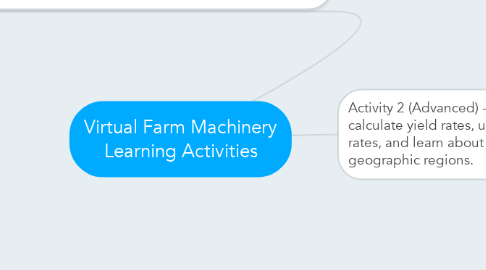
1. Activity 1 (Basic) - Tillage Efficiency Lesson. Objective = Be able to calculate predicted tillage time, calculate tillage efficiency, and recommend suggestions to improve tillage efficiency.
1.1. SimTractor Virtual Game. Motivation = Fun and immersive experience
1.1.1. Determine width of tillage tool from user manual
1.1.2. Determine field size (area) by driving around perimeter with GPS measurement tool
1.1.3. Drive tractor and tillage tool operating at a set travel speed
1.1.4. Record start and end times for completely tilling the field along with implement width and field size in external worksheet
1.2. External worksheet (Word Doc). Motivation = Applied academics, see results, required for grading / scoring
1.2.1. Plug in numbers from Simtractor into chart
1.2.2. Calculate theoretical tillage time
1.2.3. Calculate efficiency between theoretical tillage time and actual tillage time
1.2.4. Students submit completed worksheets to instructor prior to SL meeting
1.3. Second Life Virtual World. Motivation = Immersive social learning experience
1.3.1. Instructor posts each students results on display boards in SL classroom
1.3.2. Students divided into small groups (3 students per group)
1.3.3. Small groups go to private area to brainstorm three suggestions to improve efficiency
1.3.4. Whole class regroups and each group shares one suggestion
1.4. Research / homework. Motivation = applied academics, construct practical ideas, required for grading / scoring.
1.4.1. Teacher locates 3 or 4 credible / open access resources on improving tillage efficiency
1.4.2. Students explore resources
1.4.3. Students write a one page technical summary on how to improve tillage efficiency
2. Activity 2 (Advanced) - Crop Rotation Lesson. Objective = be able to calculate yield rates, understand how crop rotation practices affect yield rates, and learn about common crop rotation practices in specific geographic regions.
2.1. SimTractor Virtual Game. Motivation = Fun and immersive experience
2.1.1. Determine field size (area) of fields 1, 2, 3, and 4 by driving around perimeter with GPS measurement tool
2.1.2. Determine field size (area) of field 5 by driving around perimeter with GPS measurement tool
2.1.3. Harvest wheat from fields 1, 2, 3, and 4
2.1.4. Harvest hay from field 5
2.1.5. Disk till field 1 - 5
2.1.6. Plant wheat in fields 1 - 5 and let grow to maturity (accelerate time rate in game until crop turns yellow)
2.1.7. Determine grain tank capacity of combine
2.1.8. Harvest wheat in all five fields, one field at a time, and note the number of times the grain tank filled and needed to be unloaded in each field
2.1.9. Record field sizes, grain tank capapcity, and number of full grain tanks for each field in external worksheet
2.2. External worksheet (Word Doc). Motivation = Applied academics, see results, required for grading / scoring
2.2.1. Plug in numbers from Simtractor into chart
2.2.2. Calculate yield rates (amount of crop per area) for each field individually
2.2.3. Calculate average yield rate for field 1 - 4 which were planted wheat for two seasons in a row
2.2.4. Calculate yield increase percentage for field 5 which was rotated from hay to wheat by comparing field 5 yield rate with average yield rate of fields 1 - 4.
2.2.5. Students submit completed worksheets to instructor prior to SL meeting
2.3. Second Life Virtual World. Motivation = Immersive social learning experience
2.3.1. Instructor posts each students results on display boards in SL classroom
2.3.2. Students divided into small groups (3 students per group)
2.3.3. Each group gets assigned a different geographic region and farming application (fruit, vegetable, grain, dairy, etc.) to research common crop rotation practices
2.3.4. Whole class regroups at a second meeting after adequate research time and each group shares their findings via PowerPoint
2.4. Research / homework. Motivation = applied academics, construct practical ideas, collaborative learning, required for grading / scoring.
2.4.1. Between first and second SL meetings, students conduct their own research, locate their own credible resources, and study common crop rotation practices in their assigned geographic locations and applications. Collaborative learning strategies with specific roles for each student strongly suggested.
2.4.2. Students work together to build a presentation in PowerPoint and submit to instructor prior to second SL meeting
